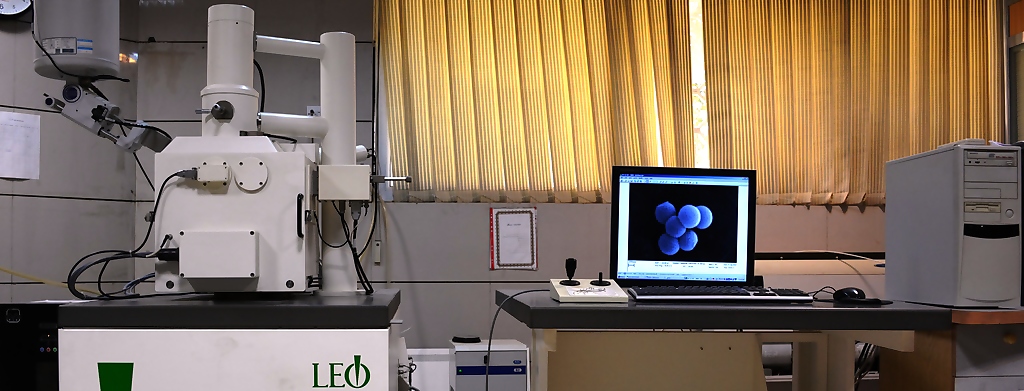LEARNING FACILITIES
- Museum of Science and Nature
- Central Laboratory
- Atomic Absorption Spectrophotometry
- Multi-Channel Battery Test System
- CHNS-O Elemental Analyzer
- GenPure ultra-pure water systems
- Scanning electron microscopy
- Gas Chromatography
- Gass Chromatography Mass Detector
- High-Performance Liquid Chromatography
- Inductively Coupled Plasma
- Liquid Nitrogen Producing Machine
- FT-NMR spectrometer
- Scanning Probe Microscopy
- Simultaneous Thermal Analyzer
- Transmission Electron Microscopy
- Electrospinning
SCANNING ELECTRON MICROSCOPY

(M0del 1455 VP Manufactured by DME)
The scanning electron microscope (SEM) uses a focused beam of high-energy electrons to generate a variety of signals at the surface of solid specimens. The signals that derive from electron-sample interactions, reveal information about the sample, including external morphology, chemical composition and crystalline structure and orientation of materials making up the sample. Signals produced by electron-sample interactions include secondary electrons (that produce SEM images), backscattered electrons (BSE), diffracted backscattered electrons (EBSD used to determine crystal structures and orientations of minerals), photons (characteristic X-rays that are used for elemental analysis and continuum X-rays), visible light (cathodoluminescence-CL), and heat. Samples for SEM need typically to be dry and conductive. Therefore, non-conductive specimens must be coated with a thin layer of metal.
The LEO 1455 VP is capable of working in both low and high vacuum and can determine the qualitative analysis of specimen. This kind of SEM is used in metallurgy, physics, biology, and nanotechnology research.
PSA
The Laser Particle Size Analyzer "ANALYSETTE 22" is an all-purpose measuring device which can be used to determine the particle size distribution of suspensions, emulsions and aerosols. Analysis devices for determination of particle size distribution with laser deflection make use of the physical principle of the scattering of electromagnetic waves.
Particles in a parallel laser beam deflect the light at a defined angle that depends on the diameter of the particles. The top of the range models NanoTec and MicroTec also include software for particle shape analysis and the measuring range extends from 0.01 to 2000 μm.
Qauntumeter
This equipment is based on optical emission spectroscopy and is used for the analysis of metallic and nonmetallic alloys and to determine their chemical compositions. The intensity of emission for each element is proportional to the concentration of that element in the sample and using standard samples and calibration curves, the percentage of the element can be calculated directly in the sample. This device has the ability to analyze alloys for base metal Fe, Ni, Zn, Cu, and Al.
BALL MILL
A ball mill is a type of grinder used to grind and blend materials for use in mineral dressing processes, paints, pyrotechnics, ceramics and selective laser sintering. It works on the principle of impact and attrition; size reduction is done by impact as the balls drop from near the top of the shell.
Thin Film Thickness Gauge
A method that utilizes the Fresnel diffraction of light from the phase step formed by a transparent wedge is introduced for measuring the refractive indices of transparent solids, liquids, and solutions. It is shown that, as a transparent wedge of small apex angle is illuminated perpendicular to its surface by a monochromatic parallel beam of light, the Fresnel fringes, caused by abrupt change in refractive index at the wedge lateral boundary, are formed on a screen held perpendicular to the beam propagation direction. The visibility of the fringes varies periodically between zero and 1 in the direction normal to the wedge apex. For a known or measured apex angle, the wedge refractive index is obtained by measuring the period length by a CCD.
Ultrasonic Probe
Sonication is the act of applying sound energy to agitate particles in a sample, for various purposes such as the extraction of multiple compounds from a sample. Sonication can be used for the production of nanoparticles, such as Nano emulsions, Nano crystals, liposomes and many other industries.

